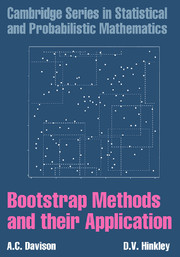Book contents
- Frontmatter
- Contents
- Preface
- 1 Introduction
- 2 The Basic Bootstraps
- 3 Further Ideas
- 4 Tests
- 5 Confidence Intervals
- 6 Linear Regression
- 7 Further Topics in Regression
- 8 Complex Dependence
- 9 Improved Calculation
- 10 Semiparametric Likelihood Inference
- 11 Computer Implementation
- Appendix A Cumulant Calculations
- Bibliography
- Name Index
- Example index
- Subject index
3 - Further Ideas
Published online by Cambridge University Press: 05 June 2013
- Frontmatter
- Contents
- Preface
- 1 Introduction
- 2 The Basic Bootstraps
- 3 Further Ideas
- 4 Tests
- 5 Confidence Intervals
- 6 Linear Regression
- 7 Further Topics in Regression
- 8 Complex Dependence
- 9 Improved Calculation
- 10 Semiparametric Likelihood Inference
- 11 Computer Implementation
- Appendix A Cumulant Calculations
- Bibliography
- Name Index
- Example index
- Subject index
Summary
Introduction
In the previous chapter we laid out the basic elements of resampling or bootstrap methods, in the context of the analysis of a single homogeneous sample of data. This chapter deals with how those ideas are extended to some more complex situations, and then turns to uses for variations and elaborations of simple bootstrap schemes.
In Section 3.2 we describe how to construct resampling algorithms for several independent samples, and then in Section 3.3 we discuss briefly the use of partial modelling, either qualitative or semiparametric, a topic explored more fully in the later chapters on regression models (Chapters 6 and 7). Section 3.4 examines when it is worthwhile to modify the statistic by using a smoothed empirical distribution function. In Sections 3.5 and 3.6 we turn to situations where data are censored or missing and therefore are incomplete. One relatively simple situation where the standard bootstrap must be modified to succeed is finite population sampling, which we consider in Section 3.7. In Section 3.8 we deal with simple situations of hierarchical variation. Section 3.9 is an account of nested bootstrapping, where we outline how to overcome some of the shortcomings of a single bootstrap calculation by a further level of simulation. Section 3.10 describes bootstrap diagnostics, which are concerned with the assessment of sensitivity of resampling analysis to individual observations, as well as the use of bootstrap output to suggest modifications to the calculations.
Information
- Type
- Chapter
- Information
- Bootstrap Methods and their Application , pp. 70 - 135Publisher: Cambridge University PressPrint publication year: 1997
Accessibility standard: Unknown
Why this information is here
This section outlines the accessibility features of this content - including support for screen readers, full keyboard navigation and high-contrast display options. This may not be relevant for you.Accessibility Information
- 3
- Cited by
